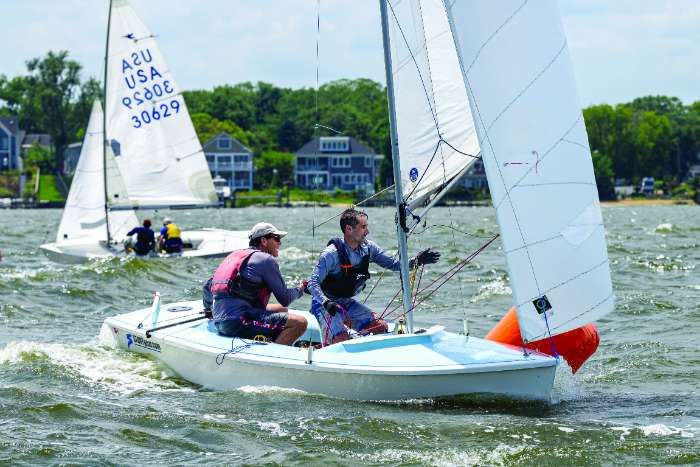Around and Around We Go! Practicing Mark Rounding in Sailing Dinghies
We’re all eager to get out on the water, but it can still be pretty darn chilly out there. It’s great to head out for some sailboat racing practice in April, but until things warm up a tad, keeping sailors active during their time on the water is important. Focusing on boat handling is a great way not only to refresh your fundamentals after a winter perhaps spent inside, but to stay warm.
One set of boat-handling skills to practice is mark roundings. When you do something multiple times each race, it’s important to have those maneuvers as smooth and effective as possible. Packing a lot of action into a short session is a great way to use early-season time. A highly physically active practice session—even as short as an hour—can pay big dividends on the racecourse.

Mark rounding practice can be done in solo sessions or in coached/group sessions. Solo sessions let you work on how you and your crew move and coordinate in the boat, including working together to minimize rudder movements. First, work on one kind of rounding. Practice weather mark roundings, making sure control lines are adjusted appropriately each time. That may mean easing some items (cracking the vang, easing the cunningham) before you reach the mark and making other changes (board up, etc.) after. Your exit from the mark is part of this adventure. Whether you have a spinnaker or not, be sure to practice gybe sets or simply gybing quickly around the mark so that you are prepared for when that’s the move to make in a race.
For leeward mark roundings, try pressing your luck. How much time do you need to get the chute and board down, jib back up, and control lines readied for upwind use? Try this in different conditions (and thus different boat speeds). And if you’re in a class that often sails courses with leeward gates, be sure to practice both starboard and port roundings. Create as much chaos as you can to really push the limits of what’s possible. When you get into a race, you can ease off the panic a bit to ensure a seamlessly smooth rounding. But you’ll know you can do a chaos rounding if you need to!
Once you’re pretty happy with doing discrete windward and leeward mark roundings, link them up: Find two items (such as marks or crab pots) you can use to set up a very short upwind/downwind leg—ideally about 30 seconds of sailing, or just one or two tacks/gybes, apart. Then, roll ‘em! Keep linking these roundings, working on getting your boat fully up to speed by getting your control lines and other settings dialed in, before you get to the next mark.
Add in a friend (or several) and possibly a coach boat, and you can add in lots of fun options to keep your brains and bodies working hard, helping you make sure your mark roundings happen as if you were on autopilot. The short-course mark roundings drill you did by yourself gets more complex when you add in one or more boats rounding at the same time. A fun one with a coach is to set up leeward gates and have two or more boats sail downwind. When you’re at about five boat-lengths to the marks, the coach hollers out which mark to round. Chaos—of the best sort!
No matter how you choose to practice your mark roundings, keep some evergreen principles and practices in mind:
How you enter a mark rounding can be important, but how you exit a mark rounding is key. Make sure your mark rounding exit sets you up for how you want to sail the next leg.
Especially if you are the driver, work on keeping your eyes out of the boat as much as possible. This lets you monitor and react to other boats and the wind conditions. If you have crew, and especially if you have practiced these maneuvers, trust that they are doing their jobs effectively. Watching them do their tasks isn’t going to make them get them done any faster!
Well before you start rounding the mark, identify where the next mark is. This can help with decisions like whether you need to toss in a gybe set or extend on starboard at the weather mark. If you’re having your initial conversation about this on the offset leg, it’s likely too late make to make optimal decisions.
About the Author: Kim Couranz has earned several national and world titles in Laser Radials (ILCA 6), Snipes, and Lightnings. She has also raced J/22s, J/24s, and Ynglings on an international level.
Find more racing tips.




